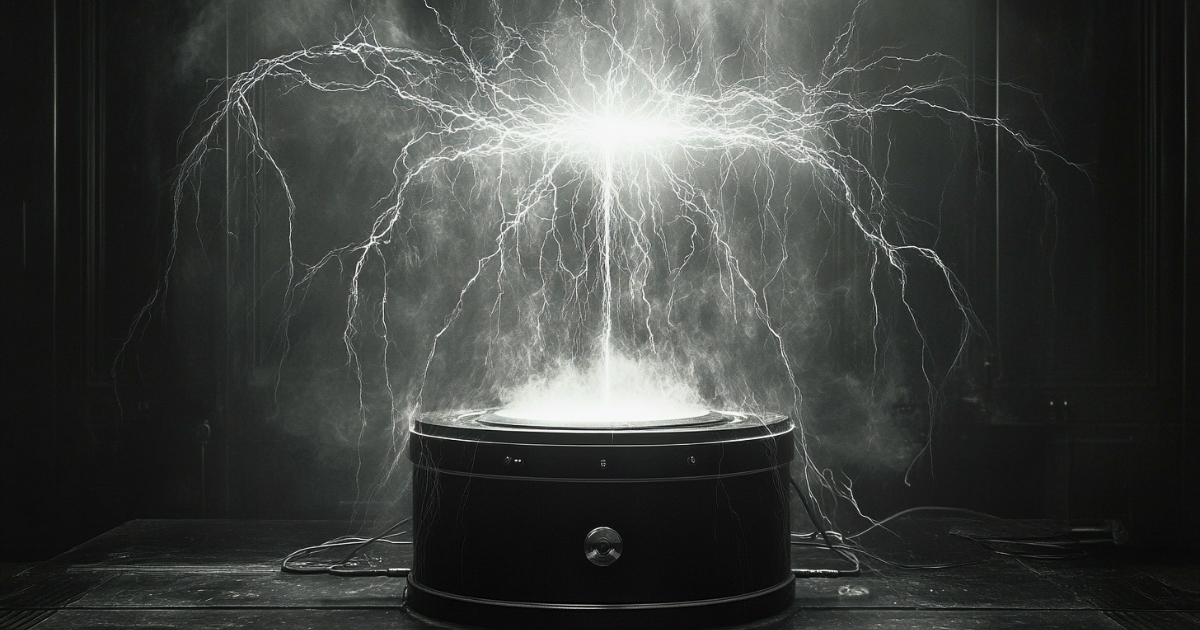Imagine a world without wires. You don’t need to search for outlets to charge your smartphone or laptop. Electric cars charge automatically while driving. And you can receive the power you need from the sky, anywhere in the world. This was the dream of a genius inventor over 100 years ago. That man was Nikola Tesla.
Tesla’s concept of wireless power transmission offers significant insights into modern energy issues. The world Tesla envisioned, with efficient use of renewable energy and equitable energy distribution, aligns with our current challenges in creating a sustainable society.
- Birth and Growth of a Genius Inventor
- Migration to America and the Dawn of an Electrical Revolution
- Wireless Power Transmission: The Beginning of a Dream
- Wardenclyffe Tower: The Embodiment of the Dream
- The Collapse of the Dream: Why It Wasn’t Realized
- Tesla’s Later Years and Legacy
- The Modern Significance of Tesla’s Dream
- Conclusion: A Message to the Future
Birth and Growth of a Genius Inventor
Nikola Tesla was born in 1856 in what is now Croatia. From childhood, he showed extraordinary imagination and inventive talent, especially excelling in the field of electricity. Tesla’s mind was always brimming with new ideas, and these sparks of inspiration would later lead to world-changing inventions.
In 1875, Tesla enrolled at the Graz University of Technology to study electrical engineering. Here, he encountered the latest electrical technologies and honed his knowledge and skills. During his university days, Tesla already had ideas for an alternating current system, but his professors dismissed them as unrealistic.
Migration to America and the Dawn of an Electrical Revolution
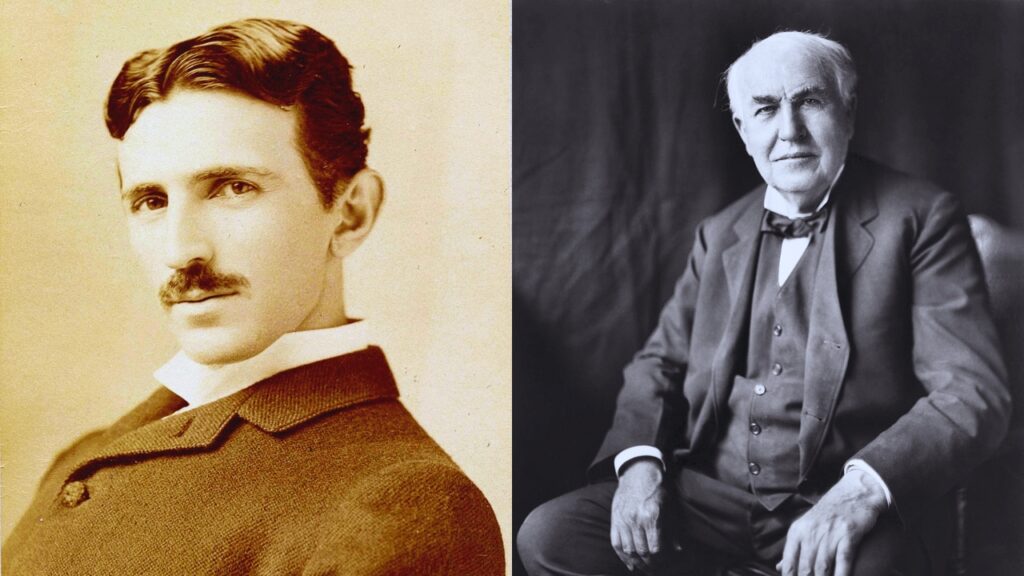
The rivals: Nikola Tesla (left) and Thomas Edison (right)
In 1884, Tesla moved to America seeking new opportunities. In America, Tesla began working under Thomas Edison, the renowned inventor of the time. However, there was a significant difference in their thinking. While Edison focused on promoting direct current systems, Tesla saw the potential in alternating current systems.
This difference developed into a fierce competition later known as the “War of Currents.” Edison’s direct current system struggled with transmitting power over distances greater than 5 kilometers. In contrast, Tesla’s alternating current system could easily step voltage up and down, making long-distance transmission possible.
In 1888, Tesla patented the alternating current motor and generator. This paved the way for the practical application of the AC system. At the 1893 Chicago World’s Fair, Tesla’s AC system was adopted, and its superiority became widely recognized.
Tesla’s inventions weren’t limited to the AC system. The Tesla Coil, a high-frequency high-voltage generator, was another of his important inventions. His achievements also extended to X-ray research and the development of fluorescent lighting, among many others.
Wireless Power Transmission: The Beginning of a Dream
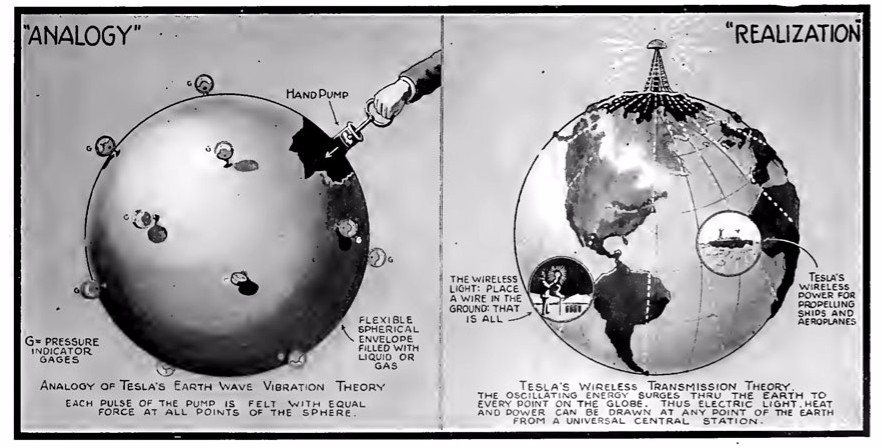
Diagram illustrating the excitation of Earth’s standing waves by pressurizing a sphere filled with a hand pump, and worldwide energy supply through wireless transmission with energy waves enveloping the Earth. This visually captures Nikola Tesla’s grand vision of “Make the whole Earth resonate and provide unlimited energy!”
However, Tesla’s ambition was even greater. He conceived a method to transmit power without wires. Tesla’s concept was to use the Earth itself as a giant conductor, releasing electricity into the atmosphere to create a system where power could be received anywhere in the world.
The principle of Tesla’s wireless power transmission involved using the ionosphere. The ionosphere is an atmospheric layer about 60-1000km above the Earth’s surface, composed of ionized gases from solar radiation. Tesla believed he could use this layer to transmit power to the other side of the Earth.
Specifically, he envisioned emitting powerful electromagnetic waves towards the ionosphere from giant transmission towers, reflecting them off the ionosphere to send them to the other side of the Earth. On the receiving end, similar towers would be built to capture the electromagnetic waves and convert them back into power.
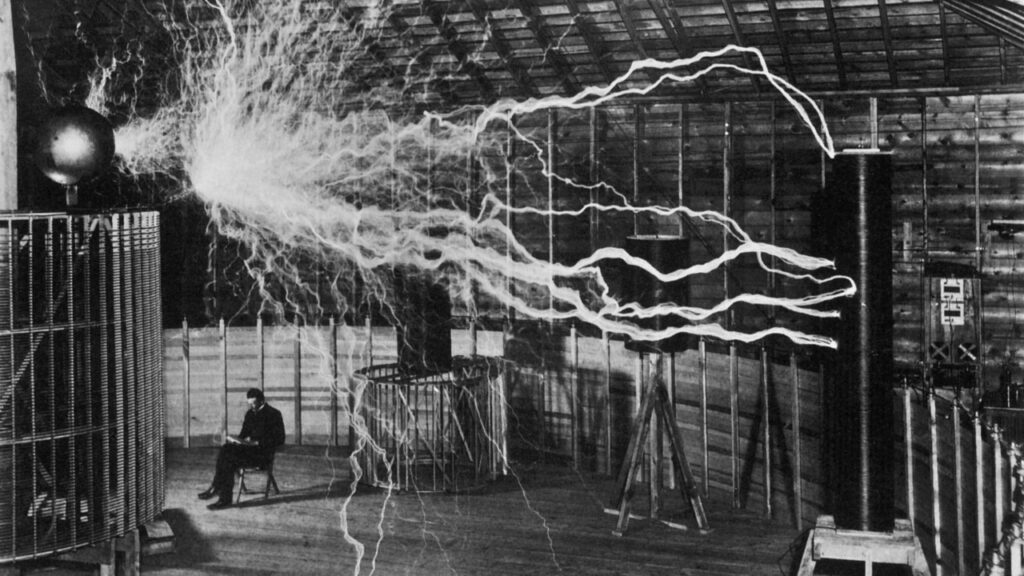
Nikola Tesla sitting next to his magnifying transmitter, demonstrating wireless electricity in his laboratory, circa 1899.
This concept shocked the scientific community of the time. Many scientists considered Tesla’s plan unrealistic. Various criticisms were raised, such as excessive energy loss and safety concerns. However, Tesla was confident in his theory.
Wardenclyffe Tower: The Embodiment of the Dream
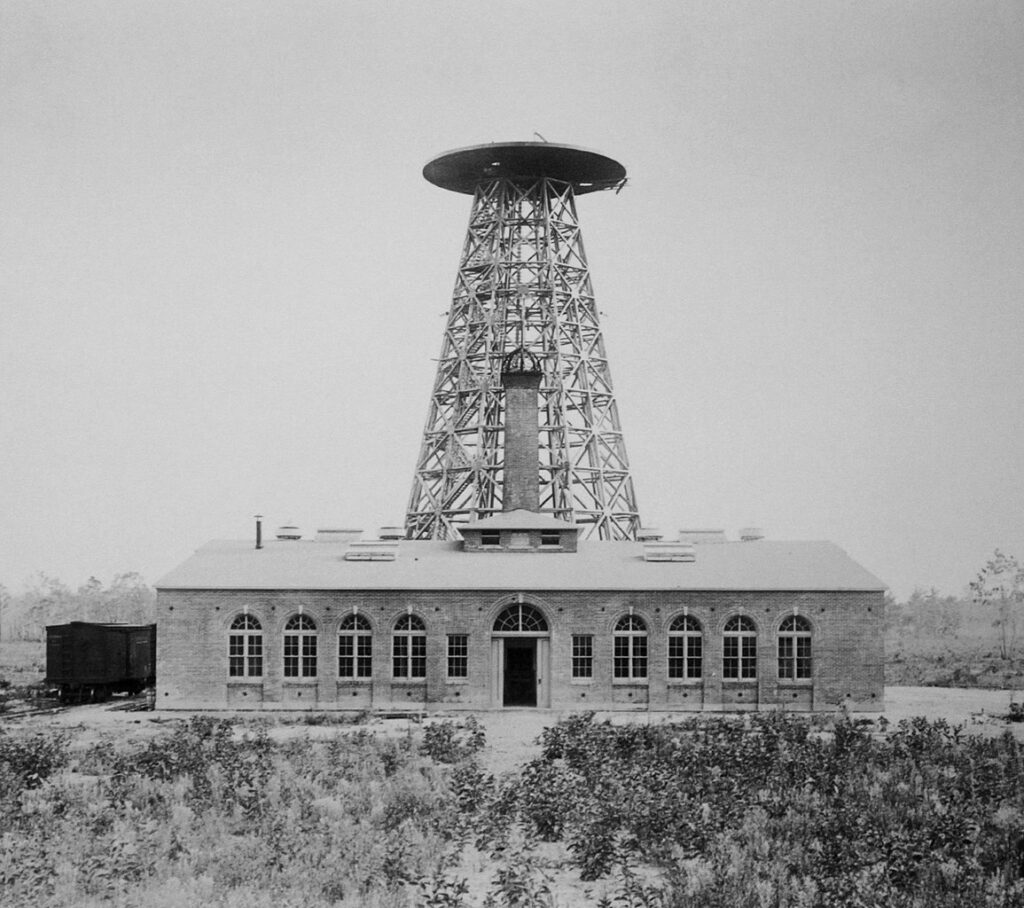
Wardenclyffe Tower: Tesla’s ambitious project for worldwide wireless power transmission.
To realize Tesla’s grand plan, construction of the Wardenclyffe Tower began in 1901 in Shoreham, Long Island, New York. This tower was a 57-meter-high wooden structure, topped with a massive 20-meter diameter hemispherical dome.
Tesla himself designed the tower. He was meticulous about every detail, from the tower’s shape and materials to its internal structure. A deep well extending 30 meters underground was dug beneath the tower, with electrodes embedded deep into the earth. This was to use the Earth itself as a giant conductor.
The construction of Wardenclyffe Tower was funded by J.P. Morgan, a wealthy financier of the time. Morgan was interested in Tesla’s concept of wireless communication and invested $150,000 (equivalent to about $4.5 million today). However, Morgan was unaware of Tesla’s true intentions. Initially, Tesla had explained that this tower was for transatlantic wireless communication.
The Collapse of the Dream: Why It Wasn’t Realized
There are several reasons why Tesla’s dream wasn’t realized. First, there were technical challenges. With the technology of the time, realizing Tesla’s concept was extremely difficult. There were numerous hurdles to overcome, including energy loss and safety issues.
Financial problems also became a major obstacle. The construction and maintenance of Wardenclyffe Tower required enormous funds, and Tesla’s personal assets were depleted. He scrambled to raise funds but couldn’t gather sufficient capital.
Furthermore, the scientific community’s response to Tesla’s concept was cold. Many scientists considered Tesla’s plan unrealistic. The idea of transmitting power wirelessly was beyond the common sense of the time.
Tesla’s own personality also made realizing the plan difficult. He preferred to keep his ideas secret and didn’t disclose details. This made it hard to gain understanding from other scientists and investors.
The changing times also had a significant impact. When World War I broke out in 1914, the U.S. government feared that the Wardenclyffe Tower might be used for German espionage activities. In 1917, the tower was demolished by government order. With this, Tesla’s dream was completely shattered.
Tesla’s Later Years and Legacy
After the failure of Wardenclyffe Tower, Tesla’s life took a downward turn. He gradually became isolated from society and fell into financial difficulties. However, Tesla never lost his passion for invention. Even in his later years, he continued to generate various ideas and obtain patents.
On January 7, 1943, Tesla passed away at the age of 87 in a New York hotel room. After his death, the U.S. government confiscated Tesla’s research materials, believing his inventions might have military value.
After Tesla’s death, his achievements were nearly forgotten for a time. However, as time passed, Tesla’s foresight began to be reevaluated. It came to be recognized that much of modern science and technology is based on Tesla’s ideas.
The Modern Significance of Tesla’s Dream
Although Tesla’s dream wasn’t realized, his ideas have greatly influenced modern science and technology. Today, we can wirelessly charge our smartphones and laptops. This can be seen as a partial realization of the dream Tesla envisioned over 100 years ago.
Moreover, attempts are being made to realize Tesla’s ideas with modern technology, such as wirelessly transmitting power from solar power satellites to Earth. Japan’s Aerospace Exploration Agency (JAXA) is advancing research on a space solar power system and plans to conduct a demonstration experiment by 2025.
Furthermore, technology development is progressing towards Tesla’s vision, such as wireless charging for electric vehicles while driving and complete wireless operation of home appliances. These technologies hold great potential for realizing a sustainable energy society.
The site of Wardenclyffe Tower is now maintained as the Tesla Science Center. Opened to the public in 2018, this center honors Tesla’s achievements and conducts research and educational activities to apply his concepts to modern times.
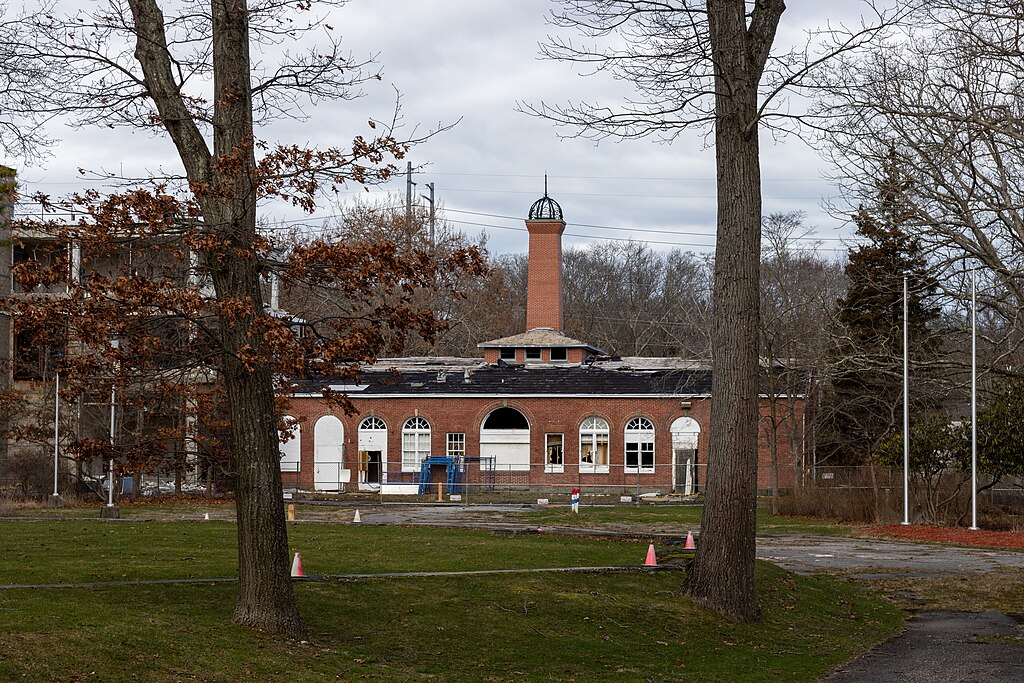
The Tesla Science Center at Wardenclyffe preserves Tesla’s legacy for future generations. Photograph by Mike Peel (www.mikepeel.net)., CC BY-SA 4.0, via Wikimedia Commons
Conclusion: A Message to the Future
Tesla’s life demonstrates how innovative ideas can be ahead of their time. Many of his concepts were impossible to realize with the technology of his era. However, these ideas have greatly influenced the development of science and technology that followed.
Tesla’s dream of wireless power transmission offers a new perspective on modern energy issues. The world Tesla envisioned, with efficient use of renewable energy and equitable energy distribution, aligns with the future we should aim for.
What should we learn from Tesla’s setbacks? It’s the importance of innovative ideas, the perseverance needed to realize them, and the necessity of social understanding and support. Tesla’s dream required not only the advancement of science and technology but also the maturity of a society ready to accept it.
Tesla’s grand vision continues to give us dreams and hope even now. The world of wireless power transmission he envisioned might someday become a reality. When that time comes, we will once again recognize how important Tesla’s dream was for human progress.
